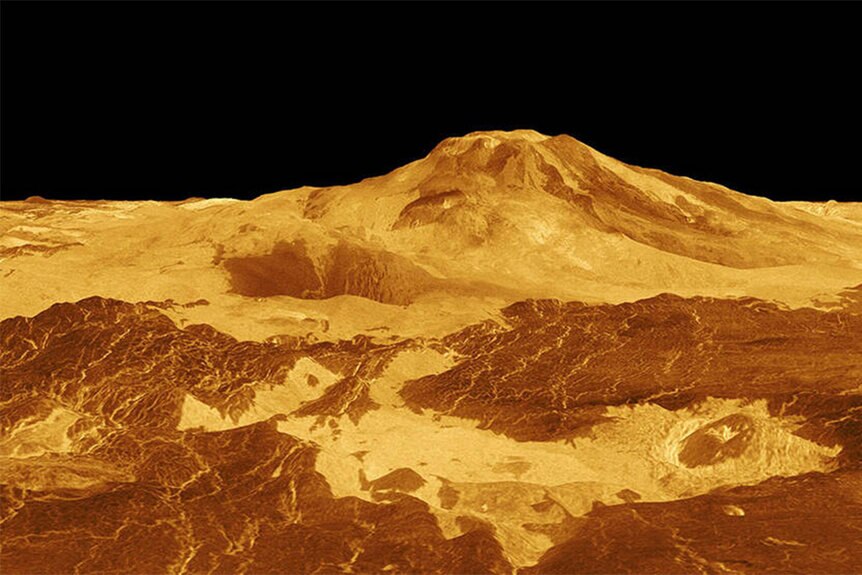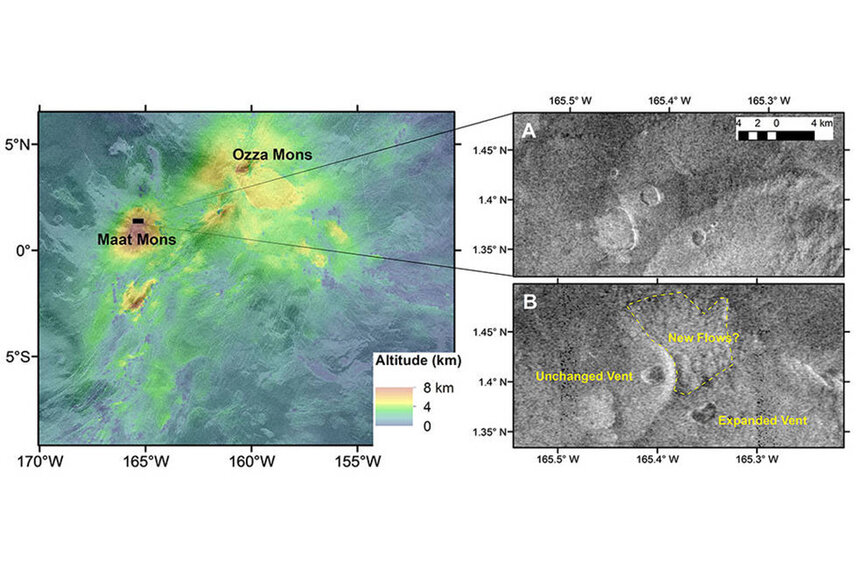Create a free profile to get unlimited access to exclusive videos, sweepstakes, and more!
Scientists find evidence of active volcano on Venus in 30-year-old Magellan images
In case Venus wasn't bad enough already.

Roger Donaldson’s 1997 disaster film Dante’s Peak begins the way so many disaster stories do: with a plucky scientist trying to get anyone to see what they see, before it’s too late. Harry Dalton (Pierce Brosnan), is a volcanologist surveying seismic activity for the United States Geological Survey. He’s stationed in the sleepy town of Dante’s Peak, which lies on the border of a dormant volcano which might not be as dormant as everyone suspects.
After finding two people boiled like hot dogs in a mountain hot spring, Dalton sounds the alarm. He is widely ignored, to everyone’s eventual horror. Volcanoes inspire fear and awe in equal measure, they are the stuff of legend, myth, and nightmare, but they are also necessary and good. If the Earth had seen its last volcanic eruption, it could only mean that the planet’s interior has gone cold. The extinction of volcanoes, earthquakes, and their subsequent tsunamis would be witness through an atmosphere increasingly baked by cosmic radiation. You can’t have volcanoes without an active interior, but you can’t have a magnetic field either. A world without volcanoes isn’t the sort of world you’d want to live on.
RELATED: A new battery technology could be the key to robots that can survive on hellish Venus
There is evidence to suggest that Venus was once much more like Earth. Two billion years ago, give or take, it might have had liquid water oceans (but, also, maybe not), habitable surface temperatures, and an active interior which birthed volcanoes. Over the last couple of billion years, however, solar radiation baked the oceans, a crushing carbon dioxide atmosphere built up, and the volcanoes all died. Or so we thought. It turns out, Venus may have had active volcanic activity as recently as the 1990s, according to a recent study published in the journal Science.
Despite all of its similarities with Earth, Venus is an exceedingly difficult place to study, thanks to its dense atmosphere and sweltering surface temperatures. Orbiting craft struggle to pierce the murky atmosphere and landing craft are quickly crushed beneath the heat and weight of the air.
Launched in May of 1989, the Magellan spacecraft spent two years — between 1990 and 1992 — circling Venus and taking radar pictures of its surface. It was the first mission to map the entire surface of Venus, providing valuable data for scientists hoping to learn more about Earth’s evil twin.
While the images provided valuable insight, they also provided challenges. Because Magellan took pictures over an extended period, from various positions and multiple angles, none of the photos precisely lined up. In order to compare two images of the same area, Robert Herrick and Scott Hensley, from the University of Alaska Fairbanks and NASA’s Jet Propulsion Laboratory, respectively, had to look for identifying features and meticulously line them up. When they did, they found evidence that at least one Venusian volcano may have blown its top between two candid snaps.
Two images of Venus’ Atla Regio region, taken eight months apart, reveal an underground volcanic vent which appears to have changed shape. Researchers note that if the same thing had happened on Earth, it would likely have been caused by an eruption. If the same sorts of geological processes happen on Venus and Earth (and we have no reason to think they wouldn’t) then it stands to reason that a change in the vent shape should have been caused by an eruption.
RELATED: 'Dante's Peak' would look right at home on the surface of Jupiter’s volcano moon Io
That would mean, of course, that the already hellish Venusian landscape is complete with violent volcanic eruptions clouding an already opaque sky. Somehow, that feels right. It’s worth noting that the Magellan data is several decades old and has the kinds of limitations you might expect from a ‘90s -era orbiter. Namely, that the picture resolution isn’t very good. Every pixel of the Magellan images accounts for an area roughly 100 meters across. There’s enough uncertainty that the active volcanism explanation for the apparent change in the shape of the underground vent should be met with at least a little bit of skepticism. It should also be met with renewed excitement and scientific inquiry.
Discoveries like these are rarely the end of the conversation but instead provide guidance for future exploration. When humanity sends its next machines to the sweltering surface of our sister planet, we now have better of idea of where to look to see the absolute worst and most interesting destinations Venus has to offer.
If you’re looking for a taste of Venus, without the commute (or the immediate and lonely death), we suggest a short vacation to Dante’s Peak, available from Universal Pictures.




























